tire pressure NISSAN VERSA NOTE 2019 Owner´s Manual
[x] Cancel search | Manufacturer: NISSAN, Model Year: 2019, Model line: VERSA NOTE, Model: NISSAN VERSA NOTE 2019Pages: 388, PDF Size: 4.46 MB
Page 368 of 388
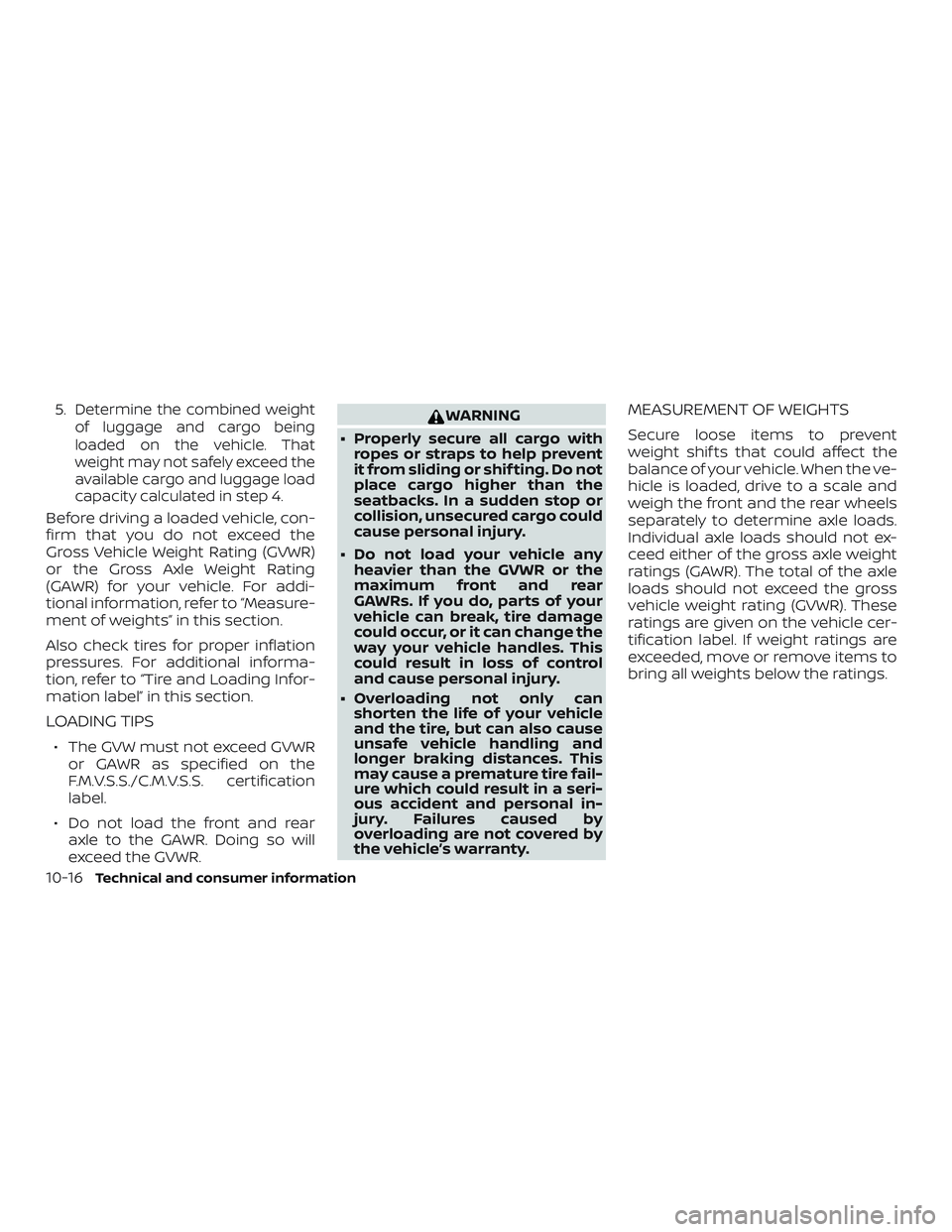
5.Determine the combined weight
of luggage and cargo being
loaded on the vehicle. That
weight may not safely exceed the
available cargo and luggage load
capacity calculated in step 4.
Before driving a loaded vehicle, con-
firm that you do not exceed the
Gross Vehicle Weight Rating (GVWR)
or the Gross Axle Weight Rating
(GAWR) for your vehicle. For addi-
tional information, refer to “Measure-
ment of weights” in this section.
Also check tires for proper inflation
pressures. For additional informa-
tion, refer to “Tire and Loading Infor-
mation label” in this section.
LOADING TIPS
∙ The GVW must not exceed GVWR or GAWR as specified on the
F.M.V.S.S./C.M.V.S.S. certification
label.
∙ Do not load the front and rear axle to the GAWR. Doing so will
exceed the GVWR.
WARNING
∙ Properly secure all cargo with ropes or straps to help prevent
it from sliding or shif ting. Do not
place cargo higher than the
seatbacks. In a sudden stop or
collision, unsecured cargo could
cause personal injury.
∙ Do not load your vehicle any heavier than the GVWR or the
maximum front and rear
GAWRs. If you do, parts of your
vehicle can break, tire damage
could occur, or it can change the
way your vehicle handles. This
could result in loss of control
and cause personal injury.
∙ Overloading not only can shorten the life of your vehicle
and the tire, but can also cause
unsafe vehicle handling and
longer braking distances. This
may cause a premature tire fail-
ure which could result in a seri-
ous accident and personal in-
jury. Failures caused by
overloading are not covered by
the vehicle’s warranty.MEASUREMENT OF WEIGHTS
Secure loose items to prevent
weight shif ts that could affect the
balance of your vehicle. When the ve-
hicle is loaded, drive to a scale and
weigh the front and the rear wheels
separately to determine axle loads.
Individual axle loads should not ex-
ceed either of the gross axle weight
ratings (GAWR). The total of the axle
loads should not exceed the gross
vehicle weight rating (GVWR). These
ratings are given on the vehicle cer-
tification label. If weight ratings are
exceeded, move or remove items to
bring all weights below the ratings.
10-16
Technical and consumer information
Page 378 of 388
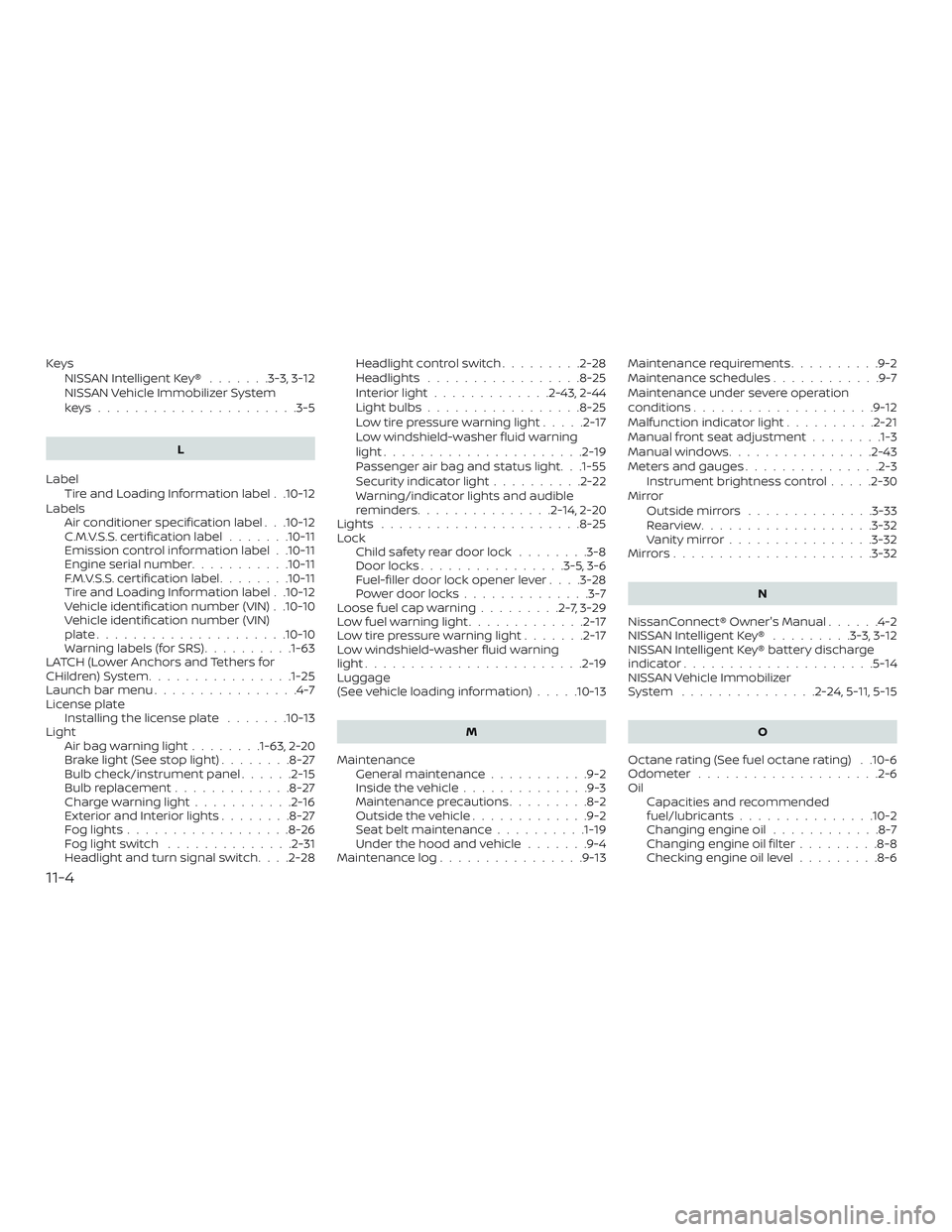
KeysNISSAN Intelligent Key® .......3-3,3-12
NISSAN Vehicle Immobilizer System
keys......................3-5
L
Label Tire and Loading Information label . .10-12
Labels Air conditioner specification label . . .10-12
C.M.V.S.S. certification label .......10-11
Emission control information label . .10-11
Engine serial number ...........10-11
F.M.V.S.S. certification label ........10-11
Tire and Loading Information label . .10-12
Vehicle identification number (VIN) . .10-10
Vehicle identification number (VIN)
plate.....................10-10
Warning labels (for SRS) ..........1-63
LATCH (Lower Anchors and Tethers for
CHildren)System................1-25
Launch bar menu ................4-7
License plate Installing the license plate .......10-13
Light Airbagwarninglight........1-63, 2-20
Brakelight(Seestoplight)........8-27
Bulb check/instrument panel ......2-15
Bulb replacement .............8-27
Charge warning light ...........2-16
ExteriorandInteriorlights........8-27
Foglights..................8-26
Foglightswitch ..............2-31
Headlight and turn signal switch ....2-28Headlightcontrolswitch.........2-28
Headlights .................8-25
Interiorlight.............2-43,2-44
Lightbulbs.................8-25
Low tire pressure warning light
.....2-17
Low windshield-washer fluid warning
light......................2-19
Passenger air bag and status light. . .1-55
Security indicator light ..........2-22
Warning/indicator lights and audible
reminders ...............2-14,2-20
Lights ......................8-25
Lock Child safety rear door lock ........3-8
Door locks ................3-5,3-6
Fuel-filler door lock opener lever . . . .3-28
Power door locks ..............3-7
Loose fuel cap warning .........2-7,3-29
Lowfuelwarninglight.............2-17
Low tire pressure warning light .......2-17
Low windshield-washer fluid warning
light........................2-19
Luggage
(See vehicle loading information) .....10-13
M
Maintenance General maintenance ...........9-2
Insidethevehicle..............9-3
Maintenance precautions .........8-2
Outsidethevehicle.............9-2
Seat belt maintenance ..........1-19
Under the hood and vehicle .......9-4
Maintenance log ................9-13 Maintenance requirements
..........9-2
Maintenance schedules ............9-7
Maintenance under severe operation
conditions....................9-12
Malfunctionindicatorlight..........2-21
Manual front seat adjustment ........1-3
Manual windows ................2-43
Meters and gauges ...............2-3
Instrument brightness control .....2-30
Mirror Outsidemirrors..............3-33
Rearview...................3-32
Vanitymirror................3-32
Mirrors......................3-32
N
NissanConnect® Owner's Manual ......4-2
NISSAN Intelligent Key® .........3-3,3-12
NISSAN Intelligent Key® battery discharge
indicator.....................5-14
NISSAN Vehicle Immobilizer
System ...............2-24,5 -11, 5-15
O
Octane rating (See fuel octane rating) . .10-6
Odometer ................... .2-6
Oil C
apacities and recommended
fuel/lubricants...............10-2
Changing engine oil ............8-7
Changing engine oil filter .........8-8
Checking engine oil level .........8-6
11-4
Page 380 of 388
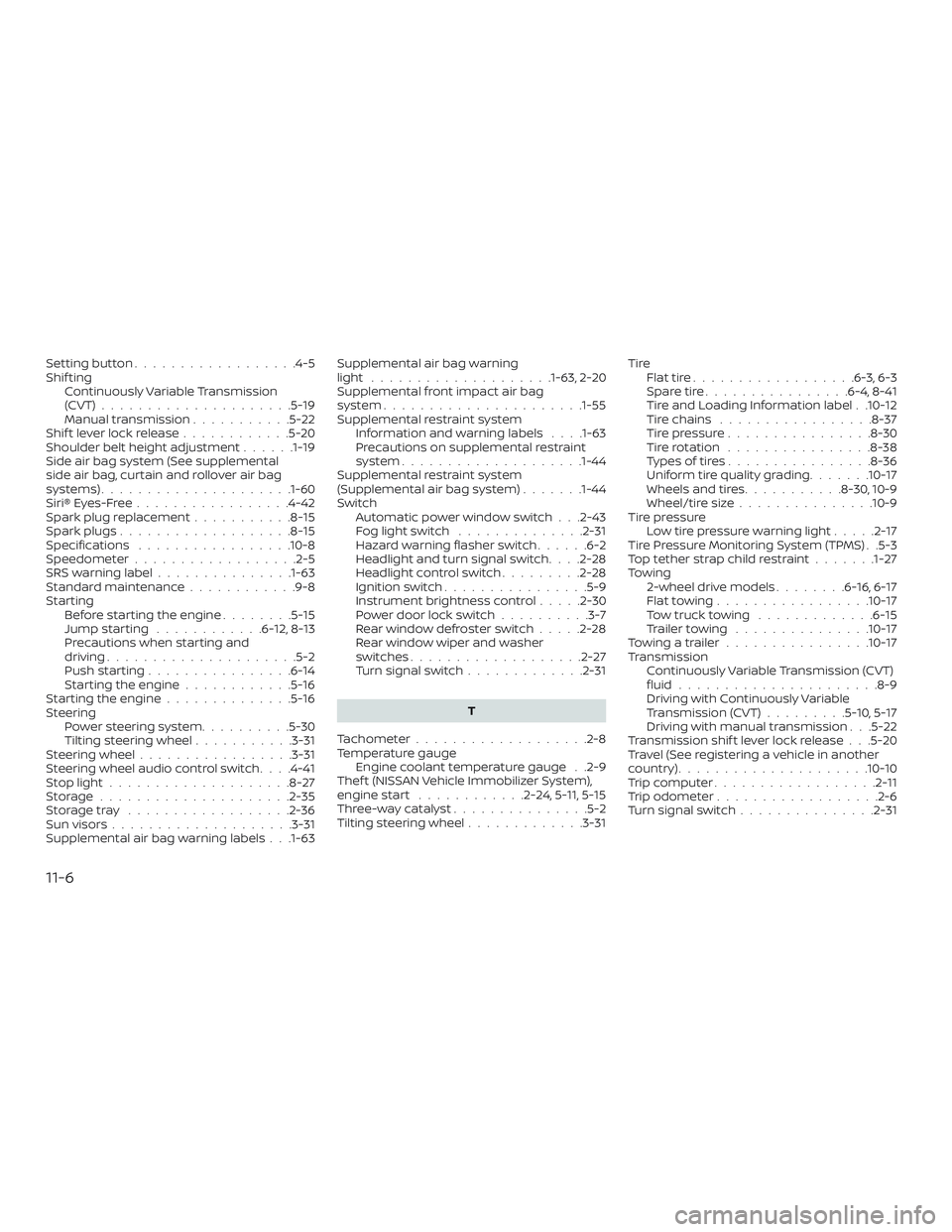
Settingbutton..................4-5
Shif tingContinuously Variable Transmission
(CVT) .....................5-19
Manual transmission ...........5-22
Shiftleverlockrelease............5-20
Shoulder belt height adjustment ......1-19
Side air bag system (See supplemental
side air bag, curtain and rollover air bag
systems) .................... .1-60
Siri® Eyes-Free .................4-42
Spark plug replacement ...........8-15
Spark plugs ...................8-15
Specifications .................10-8
Speedometer ..................2-5
SRS warning label ...............1-63
Standard maintenance ............9-8
Starting Before starting the engine ........5-15
Jumpstarting ............6-12,8-13
Precautions when starting and
driving .....................5-2
Push starting ................6-14
Starting the engine ............5-16
Starting the engine ..............5-16
Steering Power steering system ..........5-30
Tilting steering wheel ...........3-31
Steering wheel .................3-31
Steering wheel audio control switch ....4-41
Stoplight....................8-27
Storage.....................2-35
Storagetray ..................2-36
Sunvisors....................3-31
Supplemental air bag warning labels . . .1-63 Supplemental air bag warning
light ...................
.1-63, 2-20
Supplemental front impact air bag
system ..................... .1-55
Supplemental restraint system Information and warning labels . . . .1-63
Precautions on supplemental restraint
system ................... .1-44
Supplemental restraint system
(Supplemental air bag system) .......1-44
Switch Automatic power window switch . . .2-43
Foglightswitch ..............2-31
Hazard warning flasher switch ......6-2
Headlight and turn signal switch ....2-28
Headlightcontrolswitch.........2-28
Ignition switch ................5-9
Instrument brightness control .....2-30
Power door lock switch ..........3-7
Rearwindowdefrosterswitch.....2-28
Rear window wiper and washer
switches ...................2-27
Turn signal switch .............2-31
T
Tachometer ...................2-8
Temperature gauge Engine coolant temperature gauge . .2-9
Thef t (NISSAN Vehicle Immobilizer System),
engine start ............2-24,5 -11, 5-15
Three-waycatalyst...............5-2
Tilting steering wheel .............3-31 Tire
Flattire..................6-3,6-3
Spare tire ................6-4,8-41
Tire and Loading Information label . .10-12
Tire chains .................8-37
Tire pressure ................8-30
Tirerotation ................8-38
Types of tires ................8-36
Uniform tire quality grading .......10-17
Wheels and tires ...........8-30,10-9
Wheel/tir
e size ...............10-9
Tire pressure Low tire pressure warning light .....2-17
Tire Pressure Monitoring System (TPMS) . .5-3
Toptetherstrapchildrestraint.......1-27
Towing 2-wheel drive models ........6-16,6-17
Flattowing.................10-17
Towtrucktowing .............6-15
Trailertowing ...............10-17
Towingatrailer................10-17
Transmission Continuously Variable Transmission (CVT)
fluid......................8-9
Driving with Continuously Variable
Transmission (CVT) .........5-10,5-17
Driving with manual transmission . . .5-22
Transmission shif t lever lock release . . .5-20
Travel (See registering a vehicle in another
country) .....................10-10
Trip computer ..................2-11
Trip odometer ..................2-6
Turn signal switch ...............2-31
11-6
Page 381 of 388
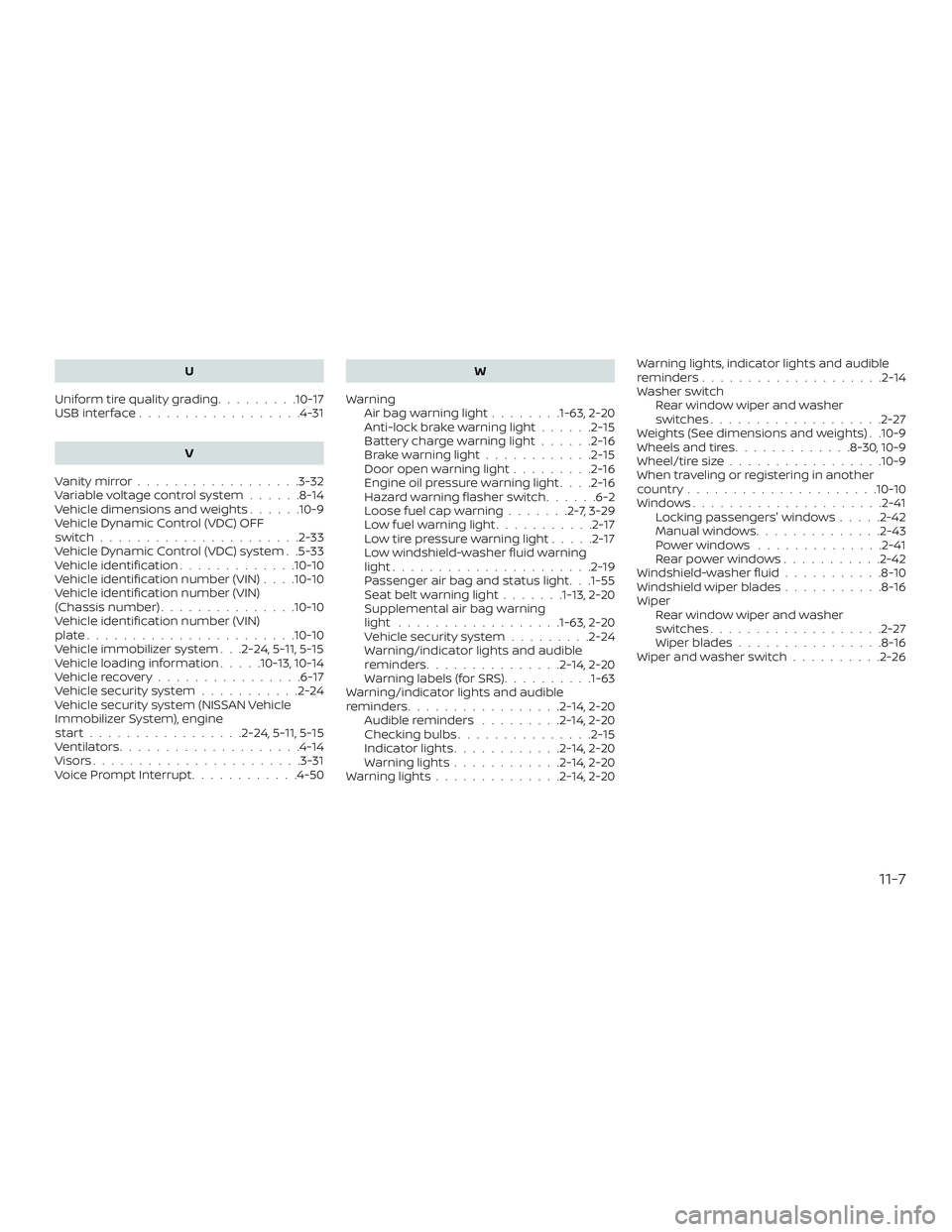
U
Uniform tire quality grading .........10-17
USBinterface..................4-31
V
Vanitymirror..................3-32
Variable voltage control system ......8-14
Vehicle dimensions and weights ......10-9
Vehicle Dynamic Control (VDC) OFF
switch......................2-33
Vehicle Dynamic Control (VDC) system . .5-33
Vehicle identification .............10-10
Vehicle identification number (VIN) . . . .10-10
Vehicle identification number (VIN)
(Chassis number) ...............10-10
Vehicle identification number (VIN)
plate.......................10-10
Vehicle immobilizer system . . .2-24, 5-11, 5-15
Vehicle loading information .....10-13,10-14
Vehiclerecovery................6-17
Vehicle security system ...........2-24
Vehicle security system (NISSAN Vehicle
Immobilizer System), engine
start.................2-24,5 -11, 5-15
Ventilators ....................4-14
Visors.......................3-31
Voice Prompt Interrupt ............4-50 W
Warning Airbagwarninglight........1-63, 2-20
Anti-lock brake warning light ......2-15
Battery charge warning light ......2-16
Brakewarninglight............2-15
Door open warning light .........2-16
Engine oil pressure warning light ....2-16
Hazard warning flasher switch ......6-2
Loose fuel cap warning .......2-7,3-29
Lowfuelwarninglight...........2-17
Lowtirepressurewarninglight.....2-17
Low windshield-washer fluid warning
light......................2-19
Passenger air bag and status light. . .1-55
Seatbeltwarninglight.......1-13, 2-20
Supplemental air bag warning
light ..................1-63, 2-20
Vehicle security system .........2-24
Warning/indicator lights and audible
reminders ...............2-14,2-20
Warning labels (for SRS) ..........1-63
Warning/indicator lights and audible
reminders .................2-14,2-20
Audible reminders .........2-14,2-20
Checking bulbs ...............2-15
Indicatorlights............2-14,2-20
Warninglights............2-14,2-20
Warninglights..............2-14,2-20 Warning lights, indicator lights and audible
reminders
....................2-14
Washer switch Rear window wiper and washer
switches ...................2-27
Weights (See dimensions and weights) . .10-9
Wheels and tires .............8-30,10-9
Wheel/tire size .................10-9
When traveling or registering in another
country .....................10-10
Windows.................... .2-41
Locking passengers' windows .....2-42
Manual windows ..............2-43
Powerwindows ..............2-41
Rearpowerwindows...........2-42
Windshield-washer fluid ...........8-10
Windshield wiper blades ...........8-16
Wiper Rear window wiper and washer
switches ...................2-27
Wiper blades ................8-16
Wiper and washer switch ..........2-26
11-7
Page 385 of 388
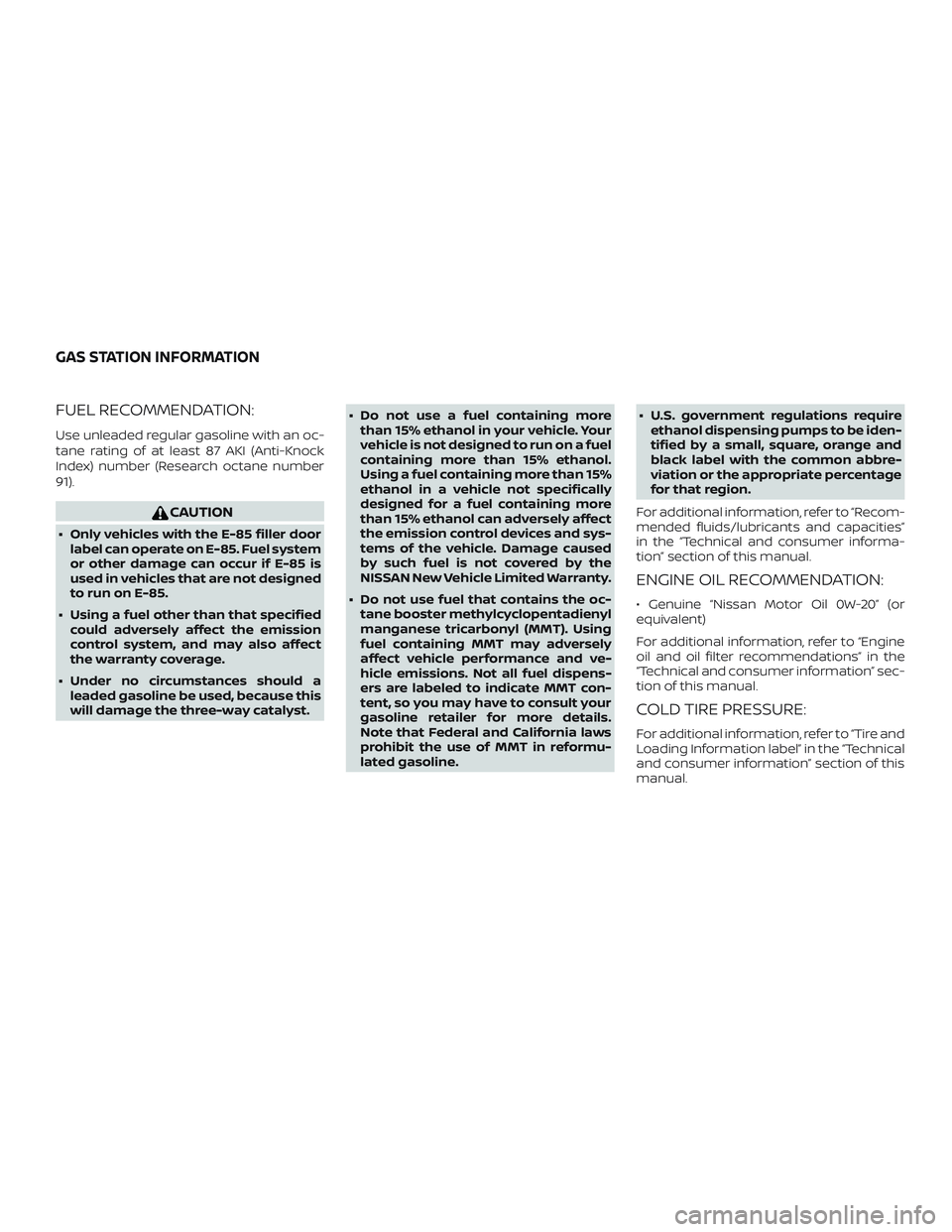
FUEL RECOMMENDATION:
Use unleaded regular gasoline with an oc-
tane rating of at least 87 AKI (Anti-Knock
Index) number (Research octane number
91).
CAUTION
∙ Only vehicles with the E-85 filler doorlabel can operate on E-85. Fuel system
or other damage can occur if E-85 is
used in vehicles that are not designed
to run on E-85.
∙ Using a fuel other than that specified could adversely affect the emission
control system, and may also affect
the warranty coverage.
∙ Under no circumstances should a leaded gasoline be used, because this
will damage the three-way catalyst. ∙ Do not use a fuel containing more
than 15% ethanol in your vehicle. Your
vehicle is not designed to run on a fuel
containing more than 15% ethanol.
Using a fuel containing more than 15%
ethanol in a vehicle not specifically
designed for a fuel containing more
than 15% ethanol can adversely affect
the emission control devices and sys-
tems of the vehicle. Damage caused
by such fuel is not covered by the
NISSAN New Vehicle Limited Warranty.
∙ Do not use fuel that contains the oc- tane booster methylcyclopentadienyl
manganese tricarbonyl (MMT). Using
fuel containing MMT may adversely
affect vehicle performance and ve-
hicle emissions. Not all fuel dispens-
ers are labeled to indicate MMT con-
tent, so you may have to consult your
gasoline retailer for more details.
Note that Federal and California laws
prohibit the use of MMT in reformu-
lated gasoline. ∙ U.S. government regulations require
ethanol dispensing pumps to be iden-
tified by a small, square, orange and
black label with the common abbre-
viation or the appropriate percentage
for that region.
For additional information, refer to “Recom-
mended fluids/lubricants and capacities”
in the “Technical and consumer informa-
tion” section of this manual.
ENGINE OIL RECOMMENDATION:
• Genuine “Nissan Motor Oil 0W-20” (or
equivalent)
For additional information, refer to “Engine
oil and oil filter recommendations” in the
“Technical and consumer information” sec-
tion of this manual.
COLD TIRE PRESSURE:
For additional information, refer to “Tire and
Loading Information label” in the “Technical
and consumer information” section of this
manual.
GAS STATION INFORMATION